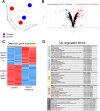Metabolic and cell cycle shift induced by the deletion of Dnm1l attenuates the dissolution of pluripotency in mouse embryonic stem cells
- PMID: 37747543
- PMCID: PMC11073397
- DOI: 10.1007/s00018-023-04962-x
Metabolic and cell cycle shift induced by the deletion of Dnm1l attenuates the dissolution of pluripotency in mouse embryonic stem cells
Abstract
Mitochondria are versatile organelles that continuously change their morphology via fission and fusion. However, the detailed functions of mitochondrial dynamics-related genes in pluripotent stem cells remain largely unclear. Here, we aimed to determine the effects on energy metabolism and differentiation ability of mouse embryonic stem cells (ESCs) following deletion of the mitochondrial fission-related gene Dnml1. Resultant Dnm1l-/- ESCs maintained major pluripotency characteristics. However, Dnm1l-/- ESCs showed several phenotypic changes, including the inhibition of differentiation ability (dissolution of pluripotency). Notably, Dnm1l-/- ESCs maintained the expression of the pluripotency marker Oct4 and undifferentiated colony types upon differentiation induction. RNA sequencing analysis revealed that the most frequently differentially expressed genes were enriched in the glutathione metabolic pathway. Our data suggested that differentiation inhibition of Dnm1l-/- ESCs was primarily due to metabolic shift from glycolysis to OXPHOS, G2/M phase retardation, and high level of Nanog and 2-cell-specific gene expression.
Keywords: Cellular metabolism; Dynamin 1 like (Dnm1l); Embryonic stem cells (ESCs); Mitochondrial fission; Pluripotency.
© 2023. The Author(s), under exclusive licence to Springer Nature Switzerland AG.
Conflict of interest statement
The authors declare that they have no conflicts of interest.
Figures






References
MeSH terms
Substances
Grants and funding
LinkOut - more resources
Full Text Sources
Research Materials
Miscellaneous

